-
Content Count
408 -
Joined
-
Last visited
-
Days Won
87
Content Type
Profiles
Forums
Gallery
Calendar
Articles
Store
Posts posted by Des
-
-
9 hours ago, MAH said:
Great post. After reading this I need to get myself sorted for some flathead fishing on the flats.
What conditions are you looking for? Is it like YFW with the tides, aiming for when they are concentrated at the bottom of the tide? What surface conditions are you looking for?
I'm off to Tackle World on Thursday night to fit out my lures with new assist hooks and then hit the flats.
Cheers
Mark
Mark, It is always the Food stupid!
 ... the saying borrowed from political campaigns ! I am sure you will get my drift
... the saying borrowed from political campaigns ! I am sure you will get my drift 
So it is all about the best conditions for the baitfish.
Always follow the baitfish.
The falling Tide is best. The baitfish retreat and congregate in weedy areas. Flathead follow and also congregate. I don't get as many on the incoming tide.
Too Windy. Little baitfish need protection and head out deeper or into sheltered deeper channels.
Too Cold. Deeper water is warmer than the chilly shallows for the sensitive baitfish. And this also applies with heat and hot water.
Overcast. Baitfish think they are safer and are more dispersed over the flats. Maybe the birds above don't see them as easily. I have trouble seeing the terrain on overcast conditions as well. No concentrated baitfish makes harder fishing.
Sunny. Bait fish head deeper and into the weeds for cover. Birds pick them off too easily in clear sunny conditions. This helps as it concentrates your fishing areas. I have had an overcast slow day turn on it's head as soon as the sun came out and stayed out.
So let us configure the idyllic day

There isn't one
 I have combed through my fishing logs to find the magic combo and there ain't one. They are on excel spreadsheets and i check results by various logged factors in ascending and descending order .... anal analysis
I have combed through my fishing logs to find the magic combo and there ain't one. They are on excel spreadsheets and i check results by various logged factors in ascending and descending order .... anal analysis 
The single most important factor is the presence of baitfish in the shallows. Then follow them depending on the conditions on the day.
In regards to the presence of baitfish ... NOW is the best. The ambient water temperatures is a primary reason. The food source created by the composting Weed Wracks increases the presence of baitfish. Spring ain't too bad either. Ambient water temperatures but not as much food for the baitfish.
Go out and get them! Good luck!
Cheers, Des
PS. Tell Tackle World to send me my commission


-
-
For the Yellow Fin Whiting Lure fanatics it is time for the withdrawal symptoms to start setting in, as the water temperatures start dropping.
Fortunately there is some pain relief, in chasing a few Flathead on lures.
Autumn brings a transition for the sandflats lure fisherman. YFW surface lure fishing drops off. Flathead lure fishing picks up. The “Southern Blue Spotted Flathead” becomes more prolific on the sandflats of the Northern SA Gulfs.
.
And it is the large accumulation of SEAGRASS WRACKS at this time of the year, along with the change in temperature, that starts it all off. Unlike the claims of some armchair academic experts, the sandflats areas where large Seagrass Wracks accumulate, is where you will find the greatest concentration of Flathead at this time of the year.
.
SEASONAL CHANGES IN THE ECOSYSTEM
It is a season of change. And multiple factors come into play.
The most fundamental change is in water temperature. Daily air temperatures have a tighter range, fortunately without those cold mornings of winter. Water temperature, currently around 18c provides the ambient conditions for baitfish. The sandflat shallows hold a lot more baitfish in these temperatures. And they linger all day in the shallows. And where baitfish linger so to do Flathead.
Also and most importantly, large Seagrass Wracks form at this time of the year.
The annual shedding of seagrass leaves through Autumn and Winter along with the higher tides and prevailing breezes, causes the accumulation of seaweed wracks in the northern SA gulfs, over these cooler months.
In the ambient autumn temperature conditions the Wracks host an explosion of life in this ecosystem.
When the organic material decomposes and breaks down it contributes to the food web systems by supplying essential nutrients. The composting seagrass accumulations are the source of detritus and of particulate and dissolved nutrients which contribute to beach and inshore marine foodwebs. Starting from (micro) zooplanktons, amphipods, bivalves, worms, crabs, juvenile prawns, clickers and … lots and lots of small baitfish. Seaweed Wracks are at the start of the food chain that delivers us the fish we catch.
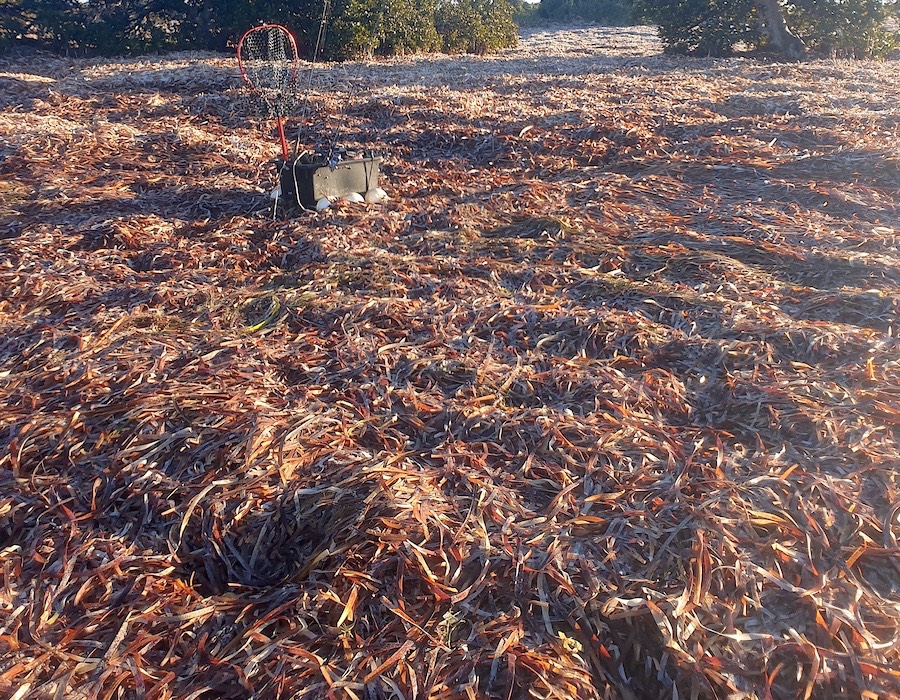
~ Weed Wracks, the start of the food chain, so thick that getting onto the sandflats can be difficult
There are many other signs that the bait fish are around in greater numbers.
Their predators gather, both from above the water and under the water.
When the Bird watching groups start reporting some big numbers of bait fish eating bird varieties, you know the water borne bait fish feeders (Flathead) will also be about.
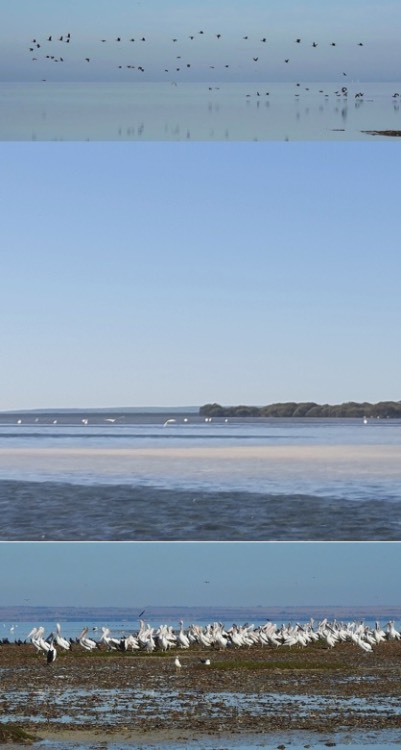
~ An abundance of Baitfish feeding Birds. A sure sign of Flathead around.
With all the indicators pointing to an abundance of Flathead, I decided to spend a couple days immersed in the northern St Vincent Gulf sandflats environment.
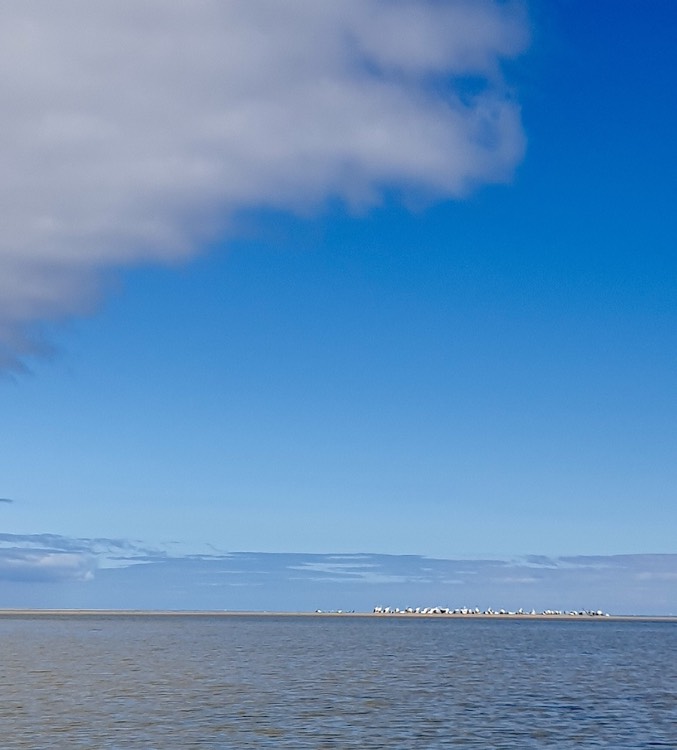
~ Catching fish is a bonus in this delightful environment
The best terrain is the weedy areas. The baitfish hold and shelter there and so do the Flathead chasing them.
Weed barren sand patches hold very few Flathead. However a few whiting are likely while traversing a Flathead barren sand patch.
.
LURE SELECTION & TECHNIQUES
I Don’t subscribe to a long held approach for lure fishing Flathead.
I don’t fish the bottom. I don’t bounce a lure across the bottom of the sand, puffing the sand.
Flathead have eyes on the top of their heads. Above their head is their main field of vision. The area that they will be concentrating on. Not so much the peripheral vision areas out in front of them on the sand.
So position your lure on top of their heads … Simple!
For this my methods include fishing Soft Plastics under a float. These days, I am mainly using floating or suspending hardbody lures. All with retro fitted assists and single hooks to avoid fouling on and cleanly pulling through the weed adjacent to the Weed Wrack areas.
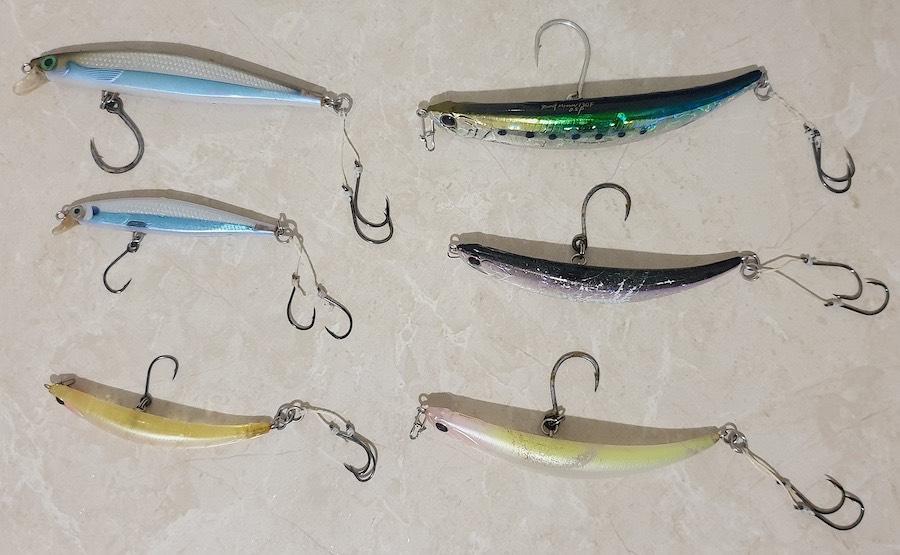
~ The successful lures on this outing. OSP Bent Minnows and Rapala Shadow Raps ~
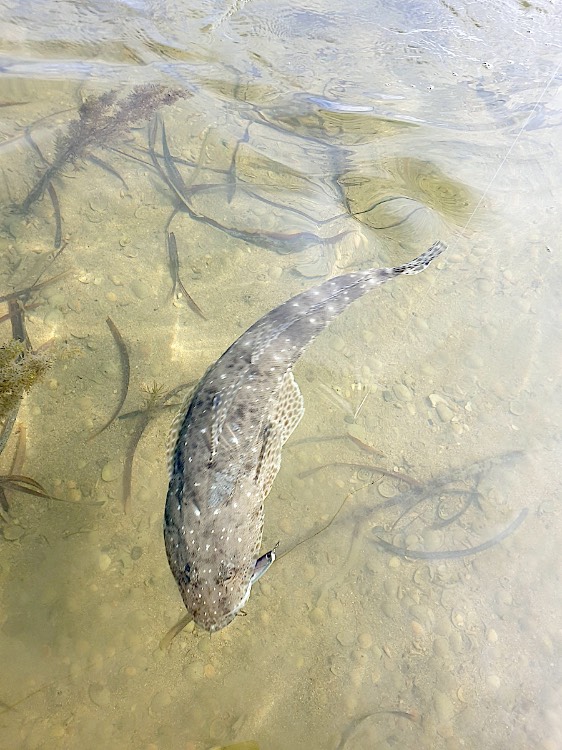
~ Another victim of the OSP Bent Minnow 106mm - Colour: H09. Crystal Blue Shiner
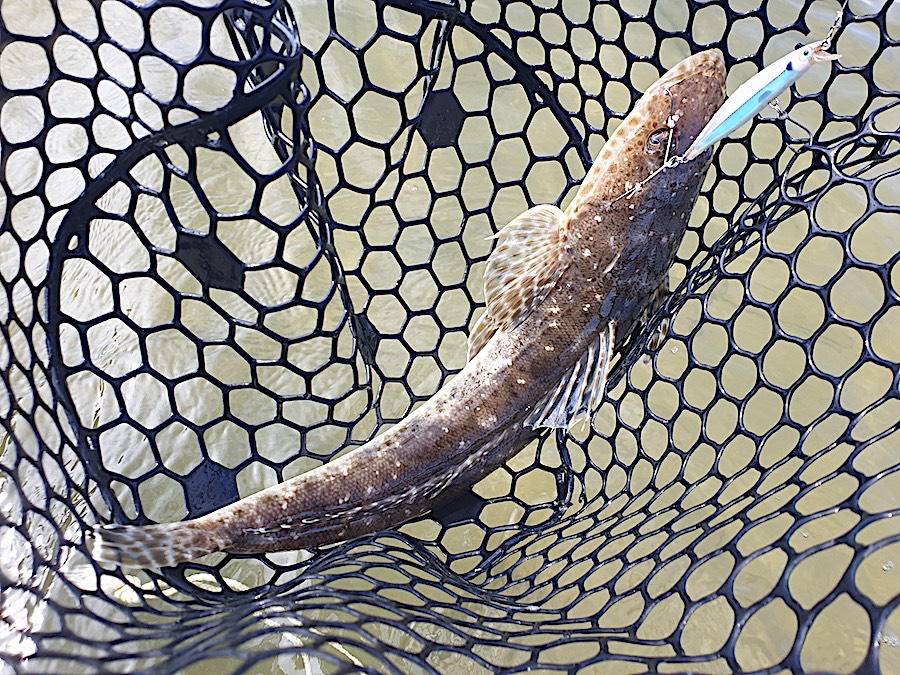
~ One on the Rapala Shadow Rap 07 - 70mm Colour: Moss Back Shiner. It pays to cast over the same area with 2 size lure offerings. Sometimes they are not in the mood for a big feed.
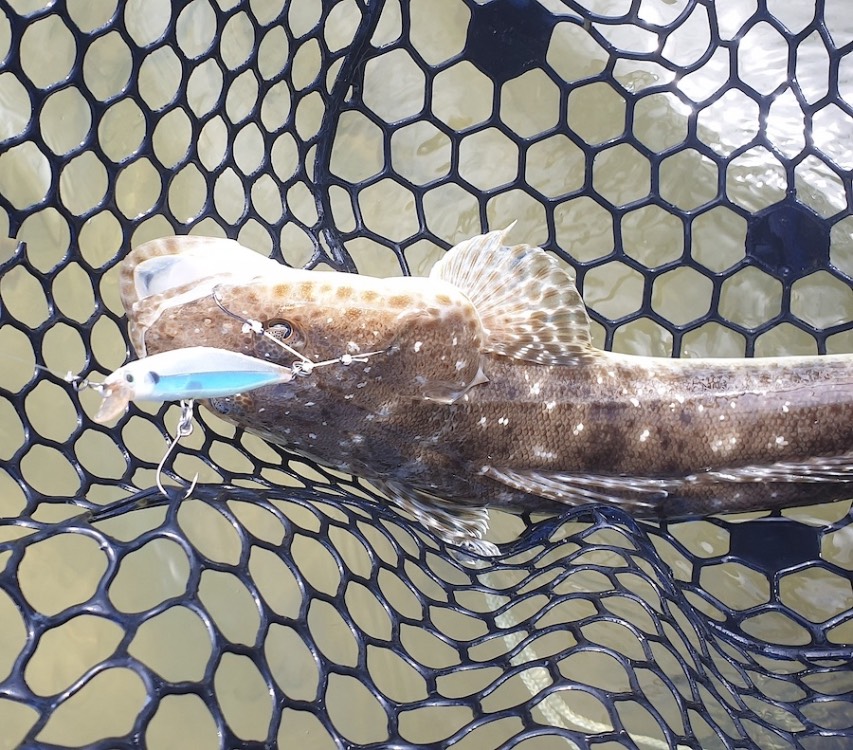
~ Assist hooks at work. Flathead can be clumsy strikers of a lure due to a blind spot created from the setting of their eyes. Apart from pulling through weed easily, assist hooks also increase your hook up rate.
This concept of fishing lures above the flathead’s eyes rather than in front of it, has in recent times gained a lot of acceptance with the enormous popularity and success of the floating glide baits now available. They hold and dance above the Flathead’s eyes.
Also bear in mind you are wading and fishing shallow water. Between knee to waist deep. So there is no need for any deep diving lures.
Currently my favourite lures are the OSP Bent Minnow and the Rapala Shadow Rap which were both successfully used on this outing
Your lure retrieval style is critical to your success rate with catching Flathead.
They do not behave like Salmon or Snook. Flathead are not morphologically evolved for chasing down bait fish like Snook or Salmon are. They lie in wait as an ambush predator with a explosive burst of speed. Often slowly stalking, following the baitfish. Then with an explosive burst lunge and seize the baitfish. Especially when the baitfish momentarily pauses.
There is plenty of drone video footage here at JC's Fishing Shenanigans of Flathead stalking baitfish … : https://www.facebook.com/JCsFishingShenanigans
As we most commonly chase Salmon & Snook with lures we have become accustomed to a fast retrieval rate. And the YFW surface lure fishers only know to retrieve fast and continuous!
The lure retrieval rate for Flathead is very slow … Extremely slow! A few erratic twitches now and then followed by a few seconds of dead pause. Should a Flathead strike and you miss the hook up. Pause again and it will most like pounce back on your lure. The stalking or hidden Flathead likes to strike when the baitfish pauses.
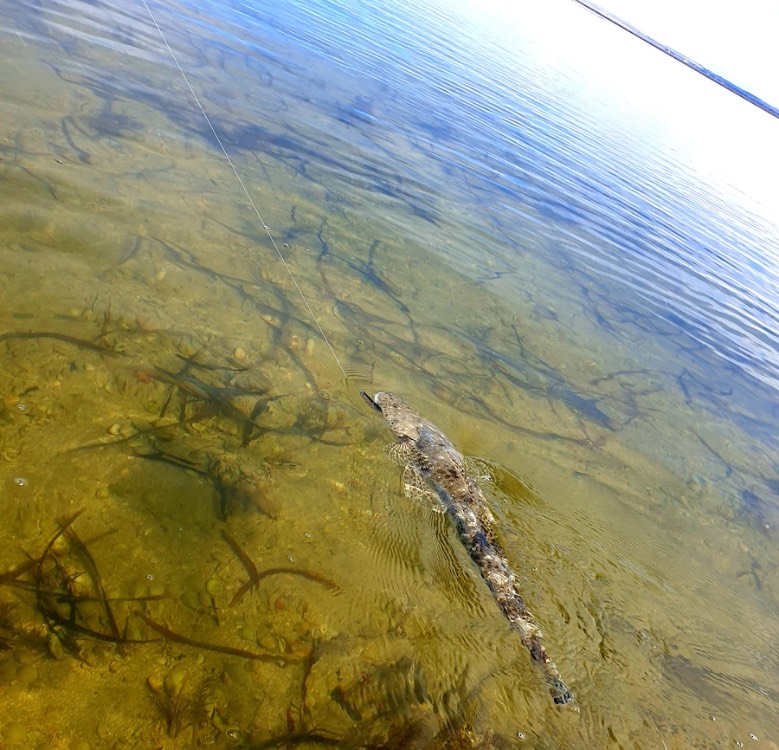
~ In knee deep shallow water they go hard. You need to play them out before gliding them into the net.
My arthritic wrists are certainly enjoying the change in retrieval tempo !
RESULTS
Over the two days of pleasant weather I covered a lot of ground, wading the sandflats, searching for and hunting down these beasts. This style of fishing does take some physical effort, but it is the most satisfying experience to successfully find your prey.
I kept 14 fish ranging from 45cm to 69cm. I even picked up a few whiting while traversing a Flathead barren, weed free sand patch.
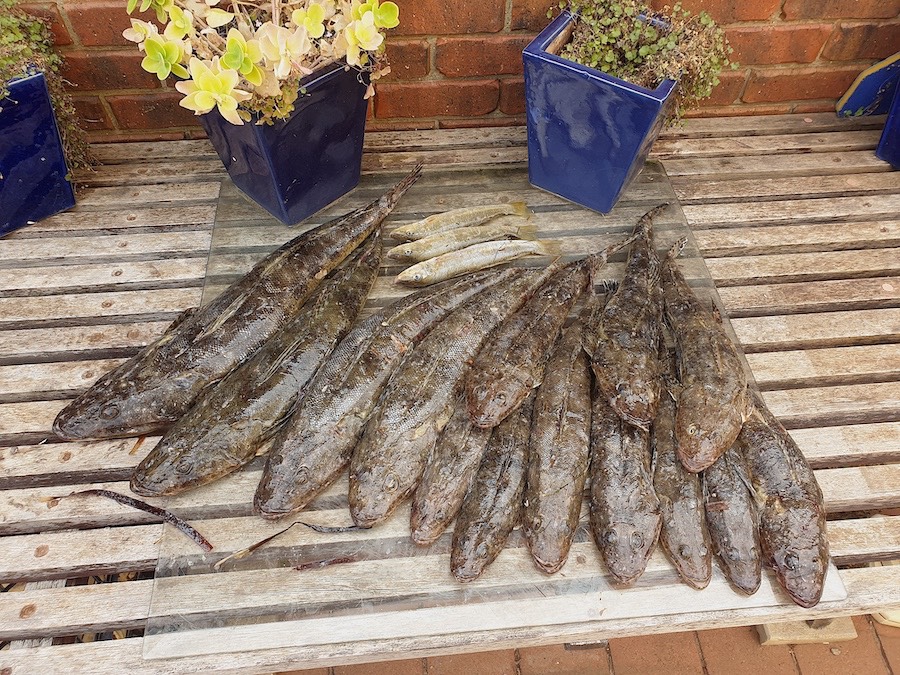
~ My catch retained for the 2 day outing. I even managed a few whiting while traversing a Flathead barren sand patch.
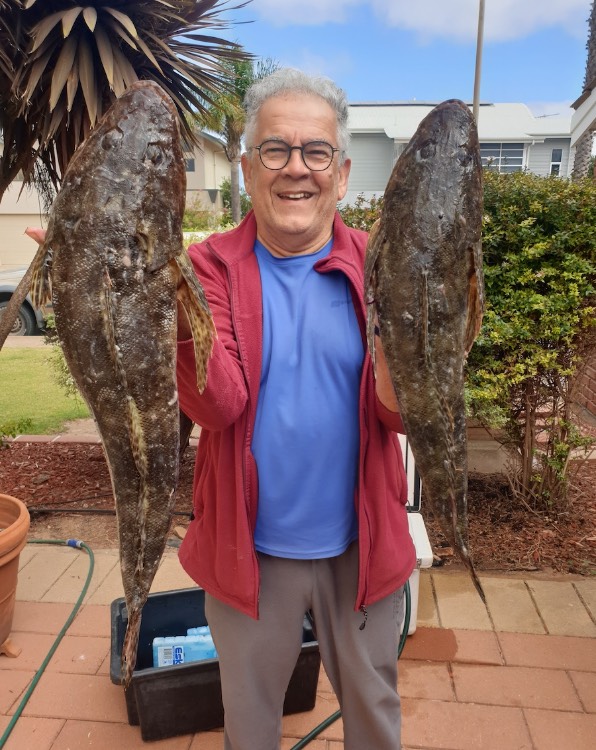
~ these Flathead are high 60s. Size enhanced by photos taken from the “Anglers Angle” !! T
I also caught and released a couple of 70+cm Flathead.
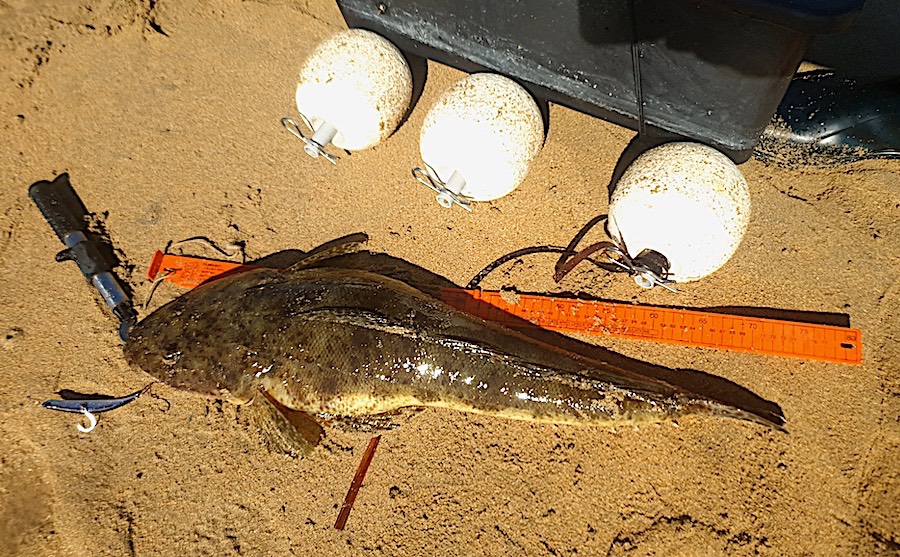
~ 75cm Blue Spot Flathead … Released
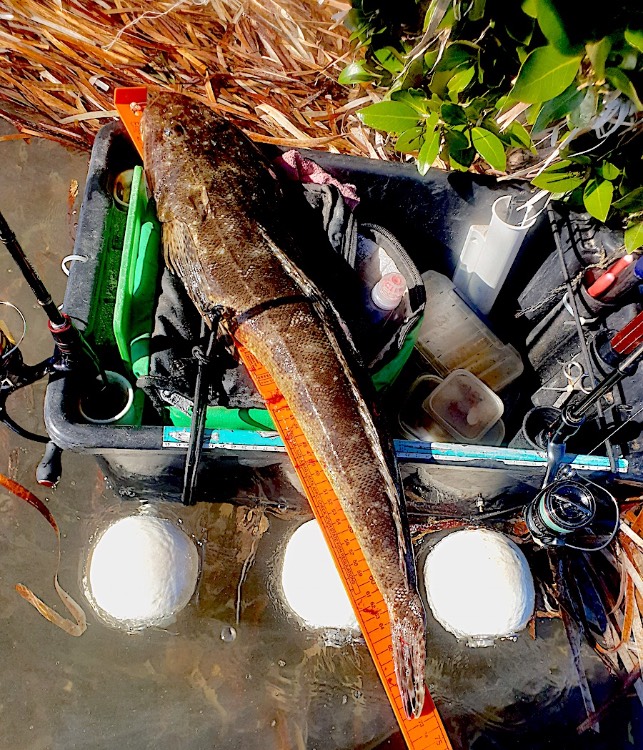
~ Taken close to the weed wracks. A 72cm Flathead … released.
So WRACK ON !!! It’s time to fish the weedy Sandflats.
Cheers and tight lines Des
-
6 hours ago, MAH said:
What size assist hooks and singles are you using?
Cheers
Mark
Hi Mark
OSP Bent Minnows 76mm or similar:
Assist Hooks Size 4: https://www.anglerswarehouse.com.au/atomic-trick-bitz-assist-hooks-no-skirt
Single Hooks Size 4: https://www.anglerswarehouse.com.au/bkk-imp-inline-single-hooks
OSP Bent Minnows 106mm or similar:
Size 1: https://www.anglerswarehouse.com.au/atomic-trick-bitz-assist-hooks-no-skirt
Single Hooks Size 2: https://www.anglerswarehouse.com.au/bkk-imp-inline-single-hooks
Rapala Shadow XRap SXR12 120mm or Atomic HARDZ SLIM TWITCHER 110mm
Size 1: https://www.anglerswarehouse.com.au/atomic-trick-bitz-assist-hooks-no-skirt
Single Hooks Size 1/0: //www.anglerswarehouse.com.au/bkk-lone-diablo-inline-single-hooks
Cheers, Des
-
The sandflats north of Adelaide, at the top of both the SA gulfs, hold some unique terrain and ecosystems. At low tide, these sandflats can drain out for over 2 kilometres. The tidal movements are, over 3 meters in St Vincents Gulf and upto 4 metres in the upper Spencers Gulf. The water temperature ranges from 11C to 25C. Typical of shallow, protected water bodies, it is a highly productive ecosystem holding a lot of fish and marine life.
It is home, for two of my favourite fishing targets, the “Southern Blue Spotted Flathead” -Platycephalus speculator and the “Yellow Fin Whiting” -Sillago schomburgkii. Both of which I obsessively chase.
.
THE TERRAIN
On the run off tide, water drains off these sandflats and into drains and channels. Which in turn, run into wide areas of seagrass beds.
The numerous schools of baitfish and juvenile prawns that feed on these extensive sandflats, now retreat back with the dropping tide, and take shelter in the weedy areas.
Such a concentration of food will always attract and hold a lot of Flathead and also the larger predatory models of Yellow Fin Whiting.
The densest weed, offers the baitfish the best protection. The Flathead will also move into the same densely weeded areas following the baitfish.
Targeting Flathead here, makes fishing for them a challenge.
With the thick weed cover the first challenge to overcome, is the reduced visibility of your lure. It is hard to present your lure clearly to the fish for a prolonged spell.
This is not as easy as fishing an open sand flat. There are only small windows of visibility in the gaps between the weeds. Only small windows of vision for the flathead below to spot baitfish above hiding amongst the flowing weed plumes.
A critical aspect in a high tidal flow area, is considering the lay of the weed with the direction of the tidal flow. The tidal flow lays the weed over creating “a directional vision”. There is greatly reduced visibility looking back into the tidal flow and into the weed flowing over.
It’s like looking through Venetian Blinds. The blinds have to be angled the right way to get a clear view out. Looking back in from the other way, you see little or nothing.
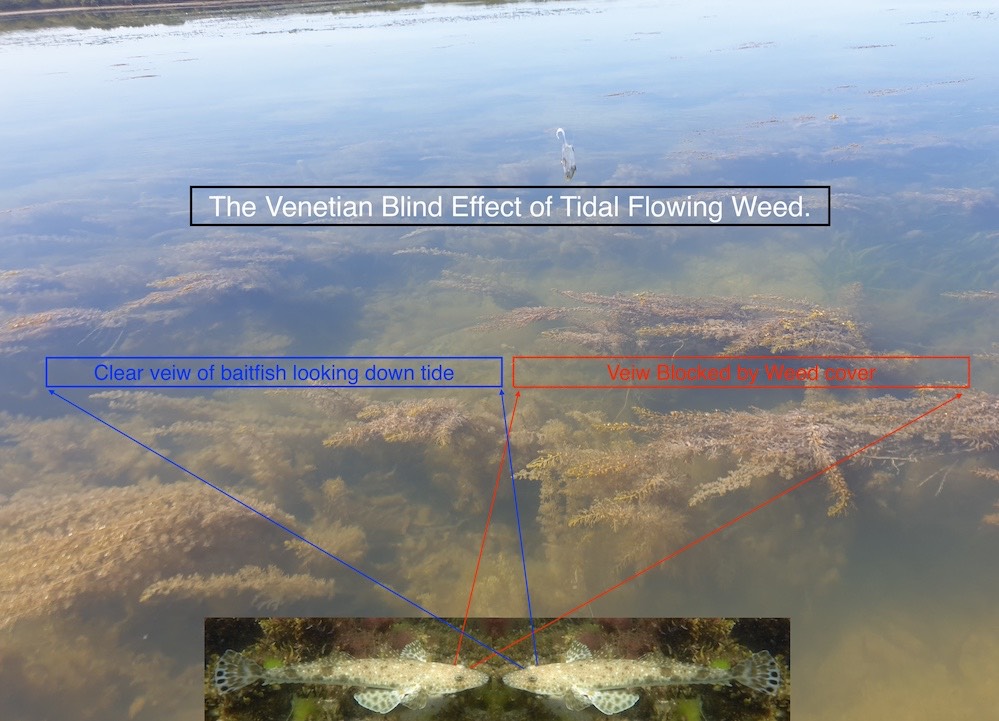
I find these Flathead facing down with the flow of the tide and not facing into the tide. With this lie, in this setting, Flathead provide themselves with the widest and clearest view through the “Venetian Blinds” of weeds. It is more effective to cast down the tidal flow and draw or suspend your lure back into the tidal flow and into the face of the flathead that is facing down the flow.
With a lot more drone footage of Flathead behaviour today, it is becoming clear that Flathead are often found laying down with the tide, rather than the popular belief of always lying into the tide.
These 2 Reels show flathead settling in with the tide, which is flowing over their backs and out in front of them. They are facing with the tide.
https://www.facebook.com/reel/250011617793874 and this
https://www.facebook.com/reel/688965732677689
.
LURE CHOICE
My go to lures are, Suspending lures, shallow diving minnows, and floating top water hardbodies.
The OSP Bent Minnows and Berkley Benders are very successful in this terrain. They provide that great erratic sideways and diving movement that immediately grabs the attention of hidden flathead.
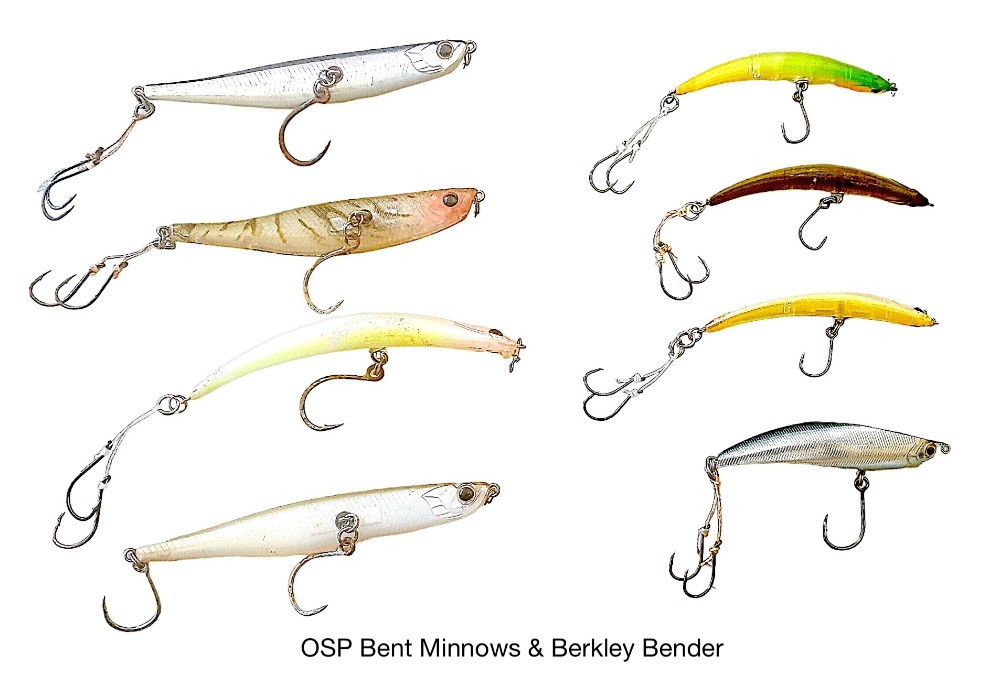
I am also using Floating shallow diving, Rapalas, Atomic Hardz and Yozuri Duel or Crystal Minnows. If the bibs are too big and makes the lure dive too deep, I grind the bib down smaller.
We are fishing shallow water upto 5ft at the deepest. And probably at best, just 2 feet of weed free water above the weed plumes.
Floating lures like Sugapens, Zipbaits Fakie Dogs, Atomic Bulldogs, which I also use for YF Whiting are also occasionally successful.
All these lures can be floated and retrieved over the weed plumes without the weed fouling the lure.
On retrieval, when the lure arrives above a window of vision between the weed, it is time for some short, shallow, diving jerks, followed by long pauses. If the tide is flowing strongly just some vibrations, dances and jiggles while the lure is holding against the tide flow and suspended above the window in the weed. This most often brings about a strike, should there be a Flathead holding there.
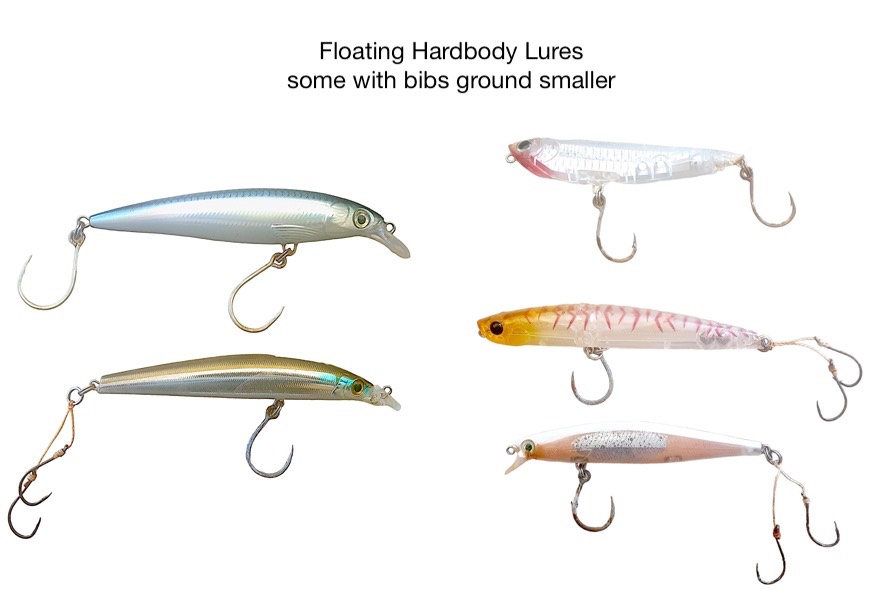
RETRO FIT HOOKS
The trebles on these lures are always replaced.
Lures with trebles catch too much weed. And when a Flathead is hooked they immediately head deeper into the weed. All the exposed treble barbs on the lure, will hook onto the surrounding weed and help the Flathead throw the lure. I lost too many fish before changing to alternative hooks.
The trebles on these lures have all been replaced with single or assist hooks.
These hooks pull through the weed easily.
I am consistently getting more strikes on the lures with assists, than with trebles.
Most importantly so far I have yet to have, a hooked Flathead throw these assist hooks.
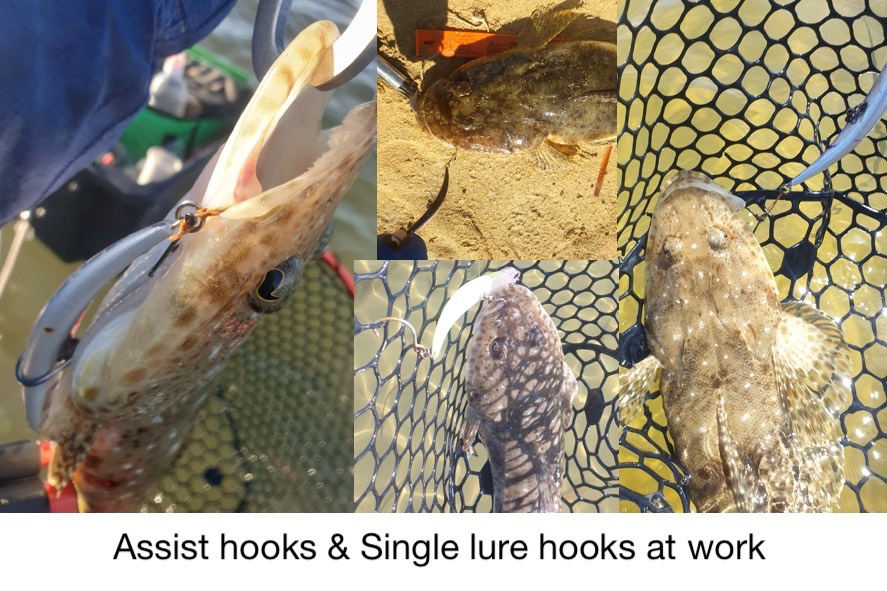
FLOAT FISHING
Soft Plastics and Metal Blades can also be used in this terrain but require employing some unconventional tactics. I suspend Soft Plastics and Metal Blades under a float. The strategy here is … If the lure sinks … put it under a Float !!!
For the same reasons that apply to the floating hardbodies.
There is a bonus in the unconventional tactic of putting lures under a float.
There seems to be a double attraction from both the float and the lure.
The float often catches the eye of the Flathead first. It attracts the Flathead’s attention, and will rise to inspect it. Although most often it quickly dismisses it.
However, it is now, in a now heightened state, and alert. The Flathead usually responds with a strong strike on the Soft Plastic following behind the float.
Occasionally the float even gets attacked.
It is not an uncommon tale, of wading SA Gar fishers having their floats attacked by a large Flathead. Occasionally they even manage to jag a Flathead with their small Garfish hooks.
Drone footage such as the many reels on here: https://www.facebook.com/JCsFishingShenanigans show Flathead stalking, monitoring, and considering the bait for quite a while, before they finally commit to taking it. And a bit of pre strike stimulus by the float, ahead of a suspended bait or lure may well help.
It does pay to hold and dance your Soft Plastic above their eyes, when it is suspended above a gap in the weeds.
Yes Bait also works !!!!
A Pilchard on 3 ganged hooks suspended under a float takes a lot of fish.
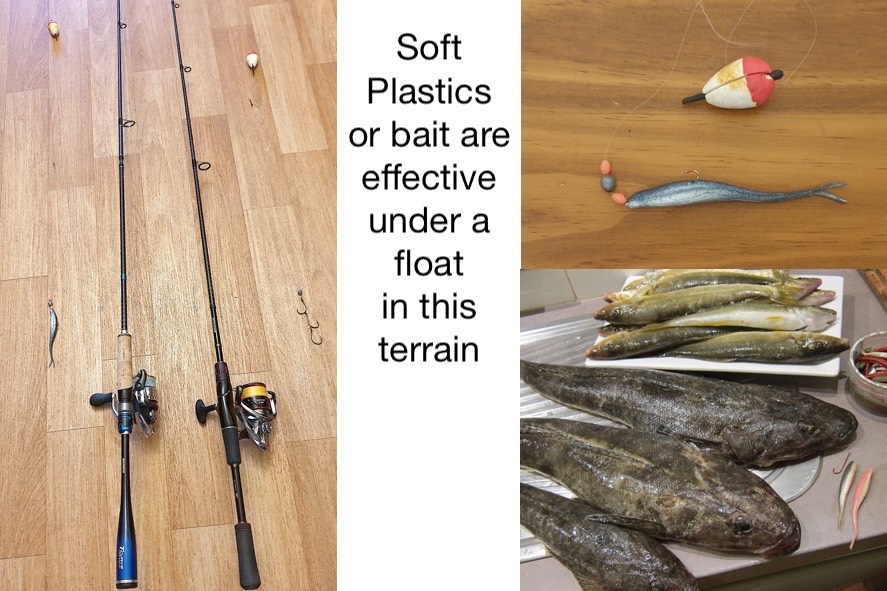
I have tried weedless hooks on Soft Plastics.
Also various SPs that are already weighted and designed as weedless. Like Zerek Weedless Fish traps. They have not been successful working them through this thick weed.
They don’t hold in the strike zone for a prolonged spell, like a floating lure suspended and dancing above the Flathead’s eyes.
Furthermore, when you do get the strike, the concealed hooks of the weedless SP options, have a significantly lower hook up rate compared to an exposed hook on a Soft Plastic or Hardbody.
.
A consistent nice by catch of these techniques are very large Whiting.
The large whiting are also ambush predators and lay in ambush in the very same area. They have the same aggressive responses.
I am sure they are Whiting identifying as Flathead !
Yellow Fin Whiting will often take SP minnows under a float in the weeded areas.
The smaller OSP Bent Minnows 75mm size are also successful with the Yellow Fin Whiting here. But your retrieve rate needs to be a lot faster than you would use for Flathead.
If I am trying for both, I will cover the same area, with the same lure, with two casts with two different styles of retrieves. One faster one to attract YFW and the other slow and pause one, to attract Flathead.
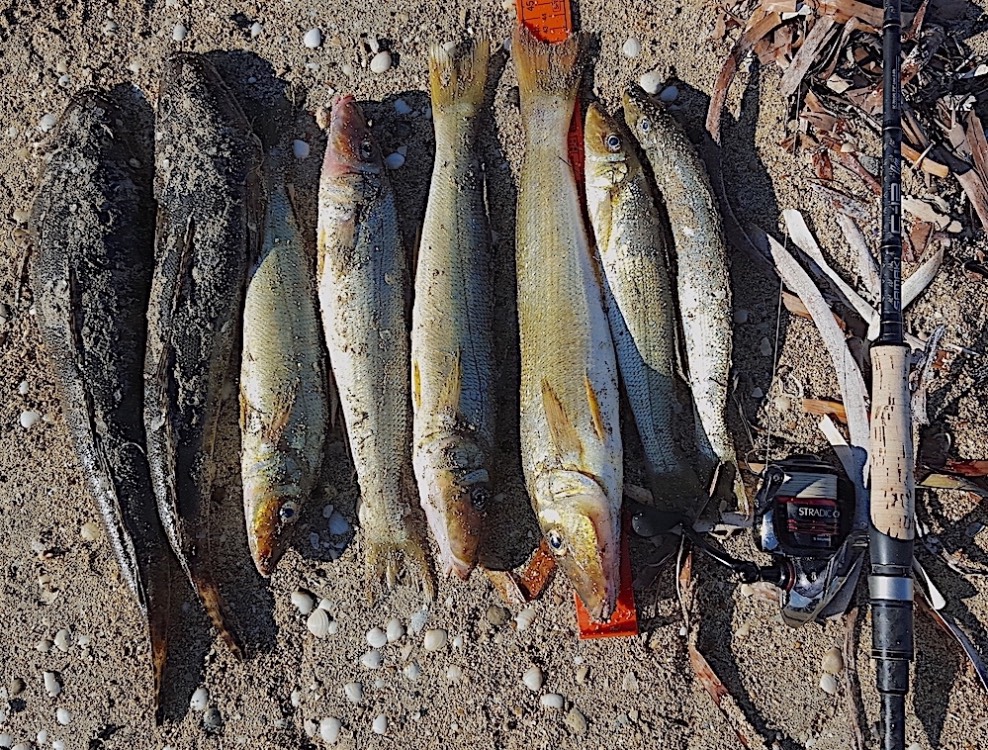
Give it a try and Have fun on the sandflats!
Cheers, Des
- Meppstas, Bilbobaggins, bjorn2fish and 1 other
-
 4
4
-
Good to know there are a few about the metro beaches.
Try keeping your bait moving. YFW love a moving bait.
So cast and slow retrieve. Or alternatively walk out to the sand bank in upto waist deep water. Then slowly walk along the sandbank trolling your bait some distance behind you.
You will have them, chasing, tapping and soon striking your bait.
Good Luck
-
3 hours ago, marlin.brando said:
That's awesome Dee, thanks for the effort of your post.
(Just a cut and paste from a previous post from Bilbo):
When you go fishing for something like carp, what kind of conditions are you looking for? eg. Morning (sunrise) or evening (sunset)? Are they more likely to be active during certain conditions?
I never bothered targeting them


But I would see people on my evening walk. More often on warmer days.
Not sure if the fishers were cooling off by the river or the Carp are more active then

Good Luck
-
STOCK DEPLETION of Yellow Fin Whiting ~ A Summary of Conversations.
.
I have engaged in a few recent conversations with many longtime Yellow Fin Whiting fishermen since my previous post: “A Threatened Species” … https://www.facebook.com/groups/1383810555282311/posts/3589648064698538/
They are experienced, talented fishers, with well established records, detailed in their many fishing reports in past fishing forums.
Stretching back well before the days of Facebook fishing groups.
They have all been unanimous in their observations of a steep decline in YFW catches.
So much so that there are gun YFW fishers that now no longer bother to target them as the returns are no longer there.
Today despite alternative claims from the Professional fishing sector, the Recreational catch of YFW in minimal.
Take a look along the metro beaches today.
No body bothers to target YFW anymore on a metro beach.
In the past you would see many family groups spend an afternoon fishing for them.
Along with the loss of catch, one must also consider the loss to the Community.
The Social and Health benefits that have also been lost along with the fish.
.
This is not a situation that has come about due to recent weather or climate variations.
This is now a well established trend stretching back numerous years.
Of particular note in my discussions, are the common observations that the steepest decline in catches, has been without doubt, since 2019.
.
THE MAIN UNDERLYING REASON FOR THE DECLINE IN YFW CATCHES, IS POOR FISHERY MANAGEMENT BRINGING ABOUT STOCK DEPLETION.
.
There is an uncanny correlation in the decline in YFW catches since 2019 and the commencement of the Snapper ban in 2019.
The Snapper Ban, obviously displaced the Professional Fisher’s Efforts.
Due to changes and restrictions forced on them, professional fishers have, by necessity, shifted their efforts towards the remaining available species including YFW. In doing so threatening the stock sustainability of many more species.
.
The Commercial Marine Scalefish Fishery Reform Advisory Committee set up in 2018 sought to address this.
A flawed conceptual process, that only considered the needs of the commercial fishing sector of the Marine Scalefish Fishery. (MSF)
It was about how to best divide a shrinking State owned resource only amongst the narrow commercial sector.
A minor sector of the community and an even more minor sector of the economy.
With little or no consideration or respect for the Recreational fishing sector and it’s economic value.
.
The Commercial Marine Scalefish Fishery Reform Advisory Committee included:
- Six, members from the commercial Marine Scale Fishery (WHAT !!! loaded!)
- one Rock Lobster Fishery member in recognition of its formal access to marine scalefish species
- One, recreational fisher in acknowledgement of the recreational sector’s interest in this shared access fishery. (Joking eh! How Tokenistic is our representation !!! )
- one independent chair, and one independent economist. (Puppets)
Little wonder the Recreational Sector has been overlooked yet again in their management reccomendations.
.
Fisheries management have been unable to deliver a key recommendation of the committee:
“Establish sustainable catch limits for all species”
The Committee Recommendations on 31st October 2019:
.
Licence buy outs were a cornerstone of proposed reforms. The last buy out of MSF licences was ineffective as most of the licences bought out were fairly inactive.
A breakdown of the licences bought, displays the ineffectiveness of the plan.
96 licences were bought. 89 were Line Licences. Only 7 were Net Licences.
It is the net licences that are decimating the YFW stocks.
So buying out 30% of the licences did not reduce the Pro catch tonnage by 30%.
It did not reduce the pressure on our fish stocks by 30%
Again ineffective fishery management hidden behind their “buyout fanfare”.
It did not set sustainable catch limits for all species.
Creating a disproportionate effort on species like YFW, that were not protected with a limit.
I am hearing claims, that PIRSA have a vested interest in maintaining as many professional licences as possible. Without a Recreational fishing licence they will not have a vested interest in the Recreational sector.
Until then they will never manage the resource equitably for ALL stakeholders.
.
Further buyouts of professional licences are required.
For these licence purchases to be effective they must directly relate to the removal of professional catch tonnages and the relevant catch quotas.
All species must have catch quotas.
So we do not see unlimited take of a commercial species, to the point of collapse.
.
However rather than decisive action from PIRSA, we are likely to see a repeat of Career Fat Cats creating another Marine Scalefish Reform Advisory Committee loaded with Commercial Marine Scalefish Fishery representatives, making more ineffective recommendations and decisions, with contemptuous disregard for Recreational fishers and their value.
.
It leaves me looking back on what has been destroyed by our Fishery Managers.
I am left only with some wonderfull memories.
Of Delightful past Tennyson Beach sessions by “BJ Slick”.
.
Cheers, Des
-
On my regular river walks, I would see successful Carp fishers in the spot indicated on my map.
Mawsons Lakes is also well known to hold a lot of big Carp
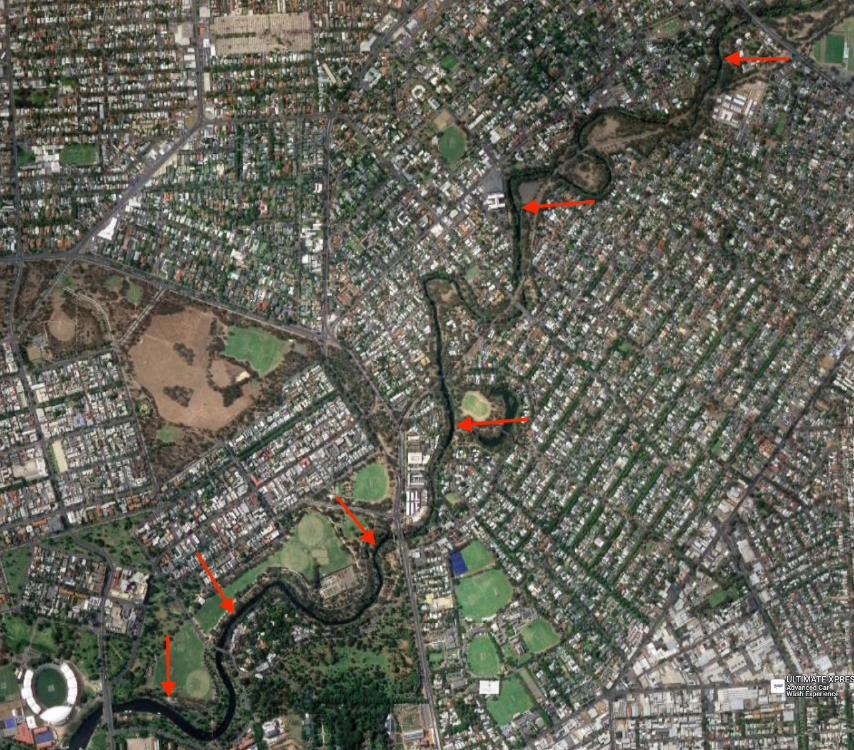
-
-
15 hours ago, Bilbobaggins said:
Hey Des, read many of your amazing posts.
I’ve ventured out to bald hill beach, Thomsons beach, parham and only ever caught meaningful fish at Thompson beach on a low tide. Are you able to let me know a well known beach that may produce some yellow fin?
I’ve tried high and low tide and only had luck on the low tide. It seems the fish are forced into the gutters in low tide which make them easier to catch.
Any pointers much appreciated. I enjoy fishing the flats in the hot weather it’s a bit of a cool off.
All those spots produced fish regularly.
Try the small tides. Both outgoing and incoming.
Fish nearer the channels that accentuate the small movement in the tide.
Pick a breezy day. Minimum 5 knots upto max 15 knots. SW is best there.
Long down wind casts towards shore into shallow shoreside water with the wind in your back.
Don't worry if your lure is landing in ankle deep water. Too often people fish too deep.
Good Luck

- Meppstas and Bilbobaggins
-
 2
2
-
I had a disastrous day last week and could only manage one Yellow Fin Whiting all day. I got the tide and the weather conditions all wrong.
I was fortunate to realise the error and managed to back it up the following day by relocating my fishing to a spot better suited to the tide and weather and finished with a bag of 20 large YFW on surface lures.
.
The sandflats of the upper SA Gulfs are a dynamic environment and ecosystem with many a variable factor that affects fishing. It keeps you thinking. Keeps you on your toes! And we don’t always get it right!
One of the most dynamic and important factors on these sandflats are the tides.
And Beware! tides also are, the greatest danger for a novice fishing these areas !
Knowing what the tide will do on any particular day is essential.
Every spot has different characteristics, where the same tide will behave differently.
For a successful fishing trip to these sandflats, you need to consider the tide along with the weather on the day. You then select the most suitable spot for those tides and those conditions.
My recent trip to the upper St.V Gulf clearly illustrated this.
.
On Day 1:
It went terribly wrong. The predicted tide was a slow steady run out all day. That did not happen. The spot was a wide sandflat. A small tide across a wide space means a slow steady water flow. That has a lot of fish lingering over the soft nipper beds. Unfortunately an unpredicted drop in air pressure and SW winds far stronger than forecast pushed against the flow and held the water at a standstill.
No flow no fish. I only ended up catching the one fish on Day 1.
.
On Day 2:
The tides and weather were very similar to the previous day. Having reconsidered the factors at play. I moved to another spot. The location was narrower, more restricted & channeled sandflat squeezed between a mangrove wall and the weedline.
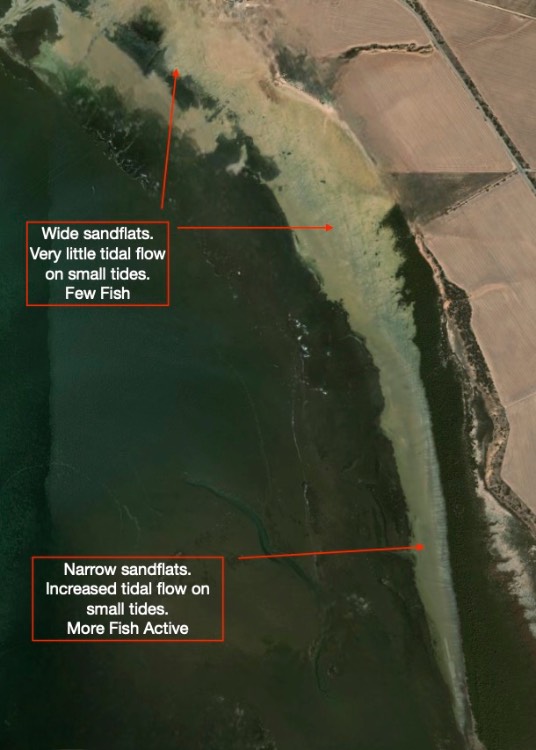
The tide flow here was quicker moving through this restricted space. And the fish were a lot more responsive. I finished with a bag of 20 quality large Yellow Fin Whiting.
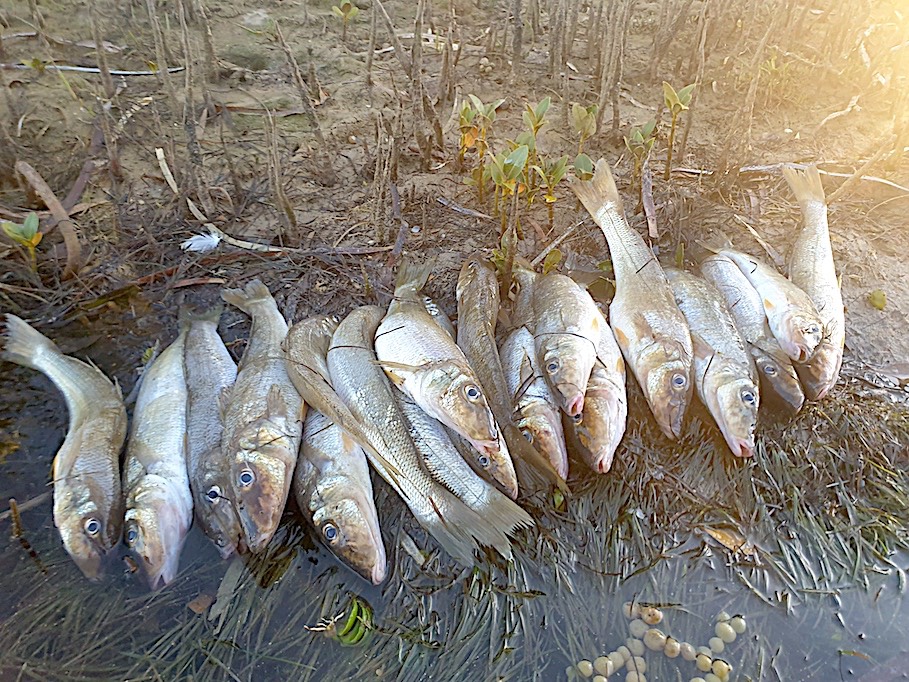
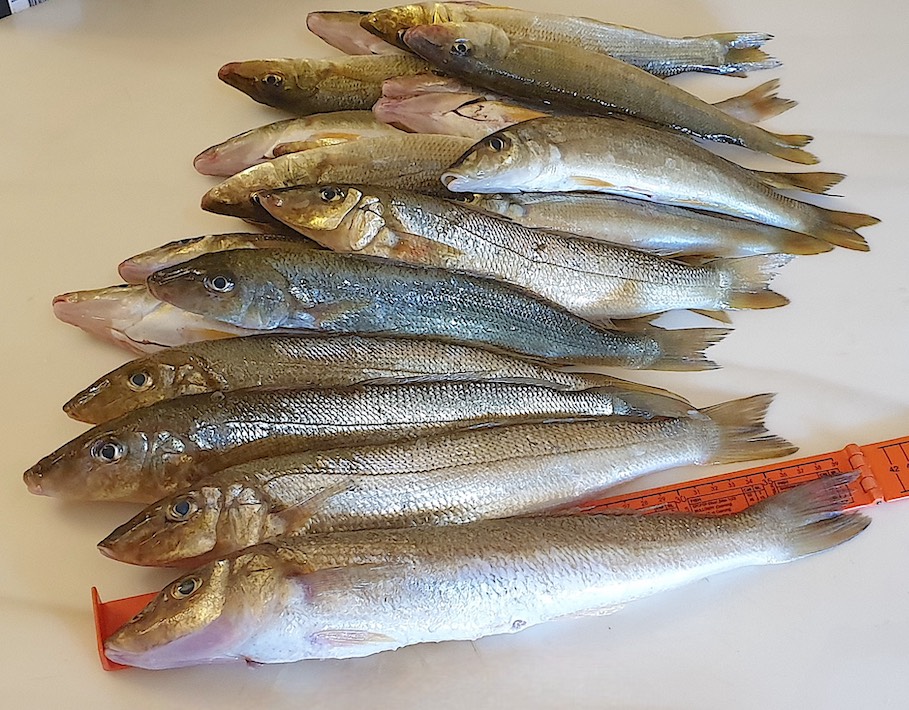
The Sugapen 95 was the most successful lure. And Zipbaits Fakie Dog DS70 took a few.
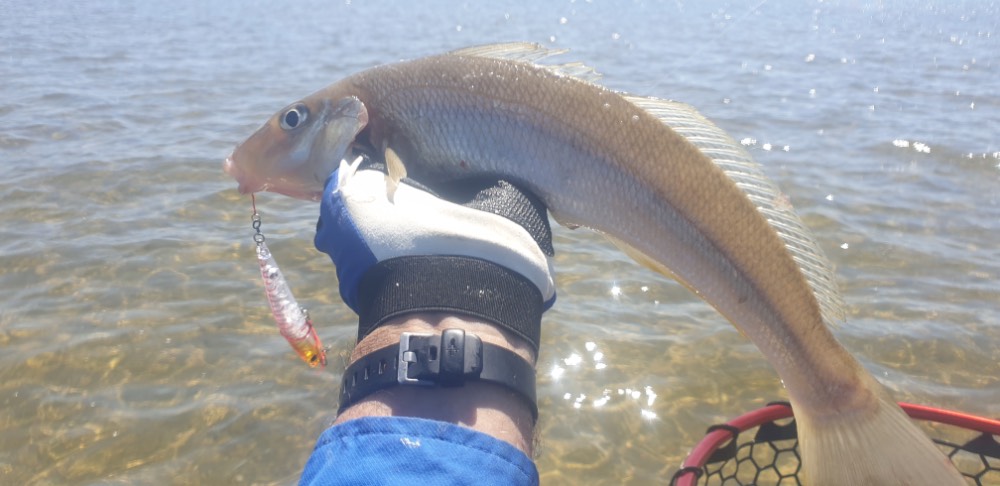
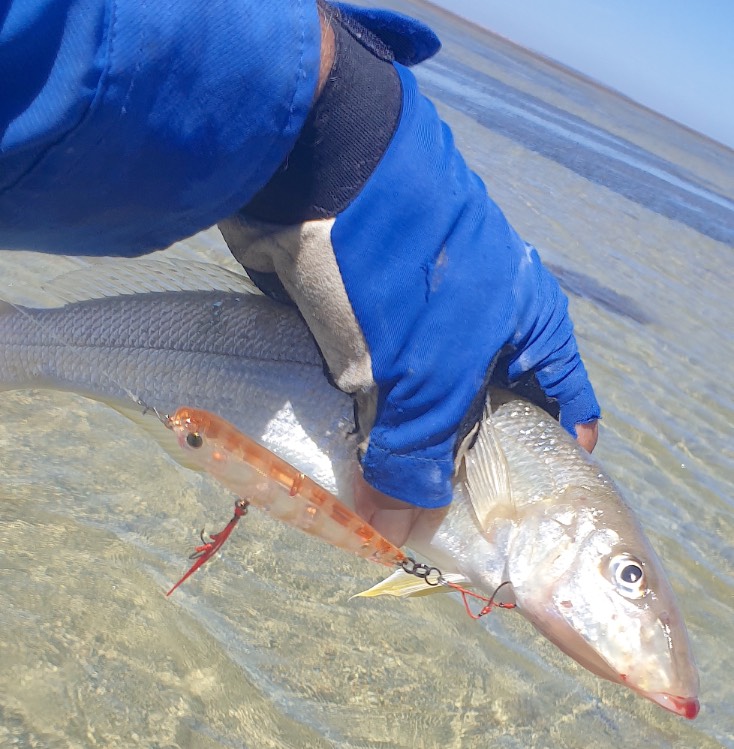
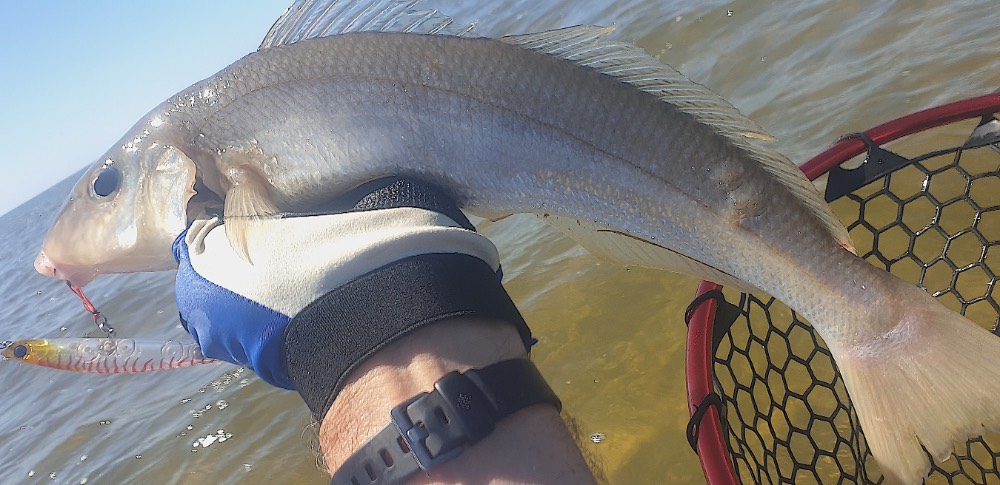
For a successful day of YFW fishing on the sandflats you need to be aware of all the tide and water flow factors.
.
GULF SHAPE, TIDE ENTRY, WINDS & TIDAL FLOWS
I do most of my fishing in the Gulf St Vincent. So this post will focus on the tidal influences on the Gulf of St Vincent Sandflats.
The very shape of the St V Gulf affects the tides in the gulf.
The first factor are the openings to the gulfs and their orientations.
To the East of K.I. the Backstairs Passage. A narrow and very restrictive entrance to the gulf. Not much water can flow through that passage. Although the tide that does, races through at a great rate.
On the West side is Investigator Strait. Which is considerably wider and the main entry point for the tide in St V Gulf tide.
If you study the tide times in the gulf, the tide arrives earlier on western side ports. This western orientation of the main gulf opening, has a major impact on tides when a SW wind blows. The SW wind or storm surge forces a lot more water up the gulf than any other wind. That will increase the tide height, considerably far more than the forecast height.
And the opposite also applies. A NE wind will force water out of the gulf, dropping the actual tide to lower than forecast.
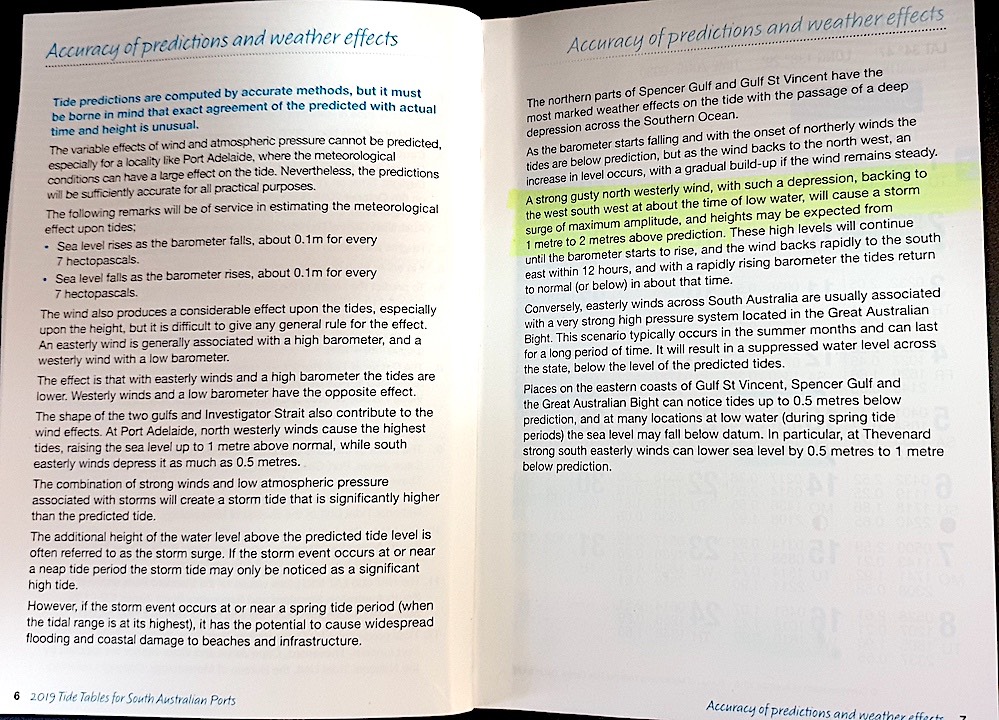
Air pressure adds a compounding factor. A lower Air pressure draws up more water and a high air pressure will force water out.
Our Afternoon Sea breezes (occasional Gale) also act similar to a SW wind. It forces more water up the gulf and increases the tide height. Particularly in the upper gulfs.
.
So if you have ever arrived at a sandflats location expecting the tide to be where you thought it should be … and it is NOT. Reconsider the above factors.
Danger is present, should these conditions come into play whilst you are out a kilometre away from the safe shore. A change in conditions can have the tide come in far faster than you have expected.
.
Our gulfs narrow at their northern ends. This amplifies any tide movement. In the constricted space of the upper gulf the tide has no where to go but up. Check the high tide on the same day. A Pt. Adelaide 2.60 mt tide, will be a 3.90 mt tide at Pt Wakefield. So in the upper gulfs the effect from any of the above variables will be amplified. Stay alert! And factor it into your fishing.
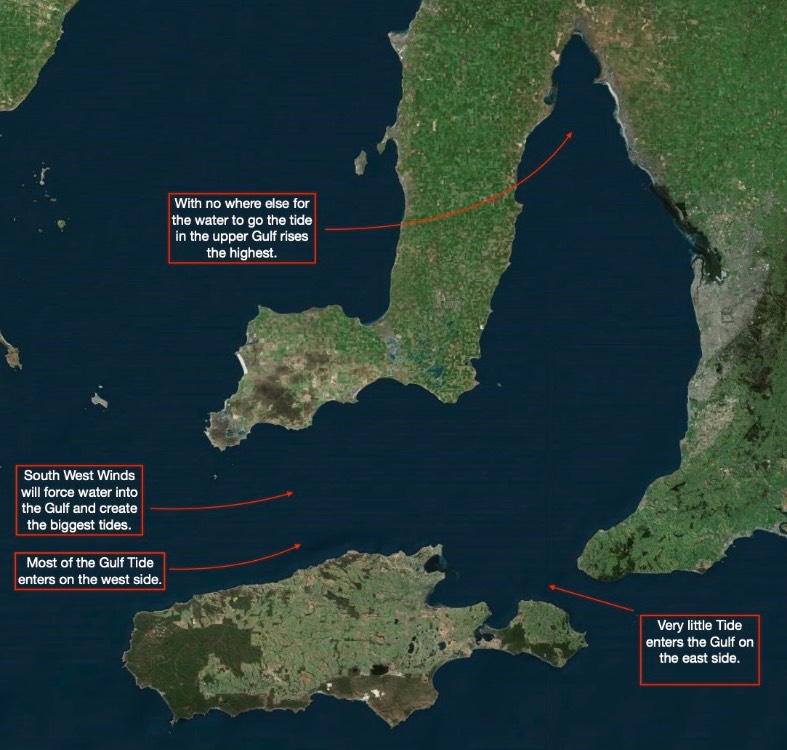
TERRAIN, & STAGE OF TIDE
Narrow areas will increase the height and speed of tide. Wider areas the reverse. This may assist or hinder our fishing depending on the weather and tide on the day.
.
It is important to know your spot and its height in regards to the low water mark.
Beware the elevated sand flats. If the tide at a spot, like Bald Hill Beach, arrives 3 hours after low, then you are obviously on the higher ground on an elevated sandflat. When the tide arrives here, it arrives at the fastest period of tide flow. Many fisherman are caught and taken by surprise in these locations.
.
Know the “RULE of TWELFTHS” . How much water comes in and when. How much more will be coming in. The Flow rate of the tide in that hour. So you can decide; do you sit it out there and keep fishing or get out of there quickly.
.
THE RULE OF TWELFTHS FOR TIDE MOVEMENTS:
- Based on the most frequent 6 hourly tide cycle experienced.
.
If we Start at LOW Tide.
There is no movement. 100% of the water movement is yet to come in.
.
1 HOUR after Low Tide:
- 1/12th of the tide moves in this hour.
- 7% of the tide has moved in, during this hour.
- 93% of the water is yet to come
.
2 HOURS after Low Tide:
- 2/12th of the tide moves in this hour.
- 25% of the tide has moved in, by the end of this hour.
- 75% of the water is yet to come
.
3 HOURS after Low Tide:
- 3/12th of the tide moves in this hour. The first of the fastest 2 hours of movement.
- 50% of the tide has moved in, by the end of this hour.
- 50% of the water is yet to come
.
4 HOURS after Low Tide:
- 3/12th of the tide moves in this hour. The second of the fastest 2 hrs of movement.
- 75% of the tide has moved in, by the end of this hour.
- 25% of the water is yet to come
.
5 HOURS after Low Tide:
- 2/12th of the tide moves in this hour.
- 93% of the tide has moved in, by the end of this hour.
- 7% of the water is yet to come
.
6 HOURS after Low Tide:
- the last 1/12th of the tide moves in this hour.
- 100% of the tide has moved in, at the end of this hour.
- No more water to come in. This is the top of the tide.
.
There have been a few occasions, when I have been counting the minutes and calculating the tide, whilst I was stranded out on a bank with water too deep to cross all around me.
Hopefully your sandflats fishing can be much more successful armed with the knowledge of these variables and their effects on your fishing.
.
Cheers and Tight lines, Des
-
On 27/12/2023 at 12:28 PM, MAH said:
You can buy gadgets like this from Aliexpress for under $50.
- Fill reel/spool with braid, then add required backing line to get perfect depth of line on your reel
- Reverse the process winding the line back onto the plastic spool (the backing line will be on the bottom)
- Use a second plastic spool to wind the line onto (the backing line will now be on top)
- Place this second spool onto the gadegt
- Wind onto the reel/spool
Worth it when you have multiple reels.
Thanks MAH.
 I wasn't aware they were around ... with the winder attached. I will look into it.
I wasn't aware they were around ... with the winder attached. I will look into it.
Cheers, Des
-
4 minutes ago, Wert said:
Oh wait, I just worked out what you meant almost immediately after submitting my long winded response above.
Yes, what you say is correct and I actually do just this on the one reel I have with a spare spool, well actually it's 2 reels I have which are the same plus a spare spool which I was able to acquire without the outrageous cost of spare spools these days (remember when reels just came with spare spools?).
For these reels full line changes are a pleasure, being able to play musical spools makes the process so much easier, top ups and reversals etc however still needs some variation on the 2 spool method.
For example if your line is a bit low, say from a bust off but you've still got plenty of braid left overall and it's still fresh you'll fill the spool to the brim with your chosen backing on top of the braid, wind this off onto a handline, wind the braid and existing backing onto the other handline then respool with the top up backing then put the original backing+braid back on.
A couple of handlines, some mono backing and a bit of imagination can make a length of braid go a very long way.
I previously got the tackle shops to do this for me. But with the increasing cost of quality braid these days I have started to source my braid elsewhere. And yes, I am topping up the backing as I shed/use up the braid above.
I have been struggling and guessing so far. This will definitely help. It will be easy for the reels that have spare spools and the multiple reels of the same size/model.
Thanks. Cheers, Des
-
1 minute ago, Wert said:
Oh wait, I just worked out what you meant almost immediately after submitting my long winded response above.
Yes, what you say is correct and I actually do just this on the one reel I have with a spare spool, well actually it's 2 reels I have which are the same plus a spare spool which I was able to acquire without the outrageous cost of spare spools these days (remember when reels just came with spare spools?).
For these reels full line changes are a pleasure, being able to play musical spools makes the process so much easier, top ups and reversals etc however still needs some variation on the 2 spool method.
For example if your line is a bit low, say from a bust off but you've still got plenty of braid left overall and it's still fresh you'll fill the spool to the brim with your chosen backing on top of the braid, wind this off onto a handline, wind the braid and existing backing onto the other handline then respool with the top up backing then put the original backing+braid back on.
A couple of handlines, some mono backing and a bit of imagination can make a length of braid go a very long way.
 I was just about to explain
I was just about to explain
-
On 22/12/2023 at 12:31 PM, Wert said:
Load up the braid first, tie on the backing and fill to the spool's capacity then reverse it, can't go wrong this way.
It shouldn't take too long either and this way you get it perfect first go.
Getting my head around that

For this to work accurately, you will need 2 spools of exact same size and capacity. (good idea BTW)
Or is there something I am missing?
-
On 3/12/2023 at 12:36 PM, Kelvin said:
Same $35 reel sold from a WA store for $226
That is actually a totally illegal practice.
That is clearly illegally "passing off" under the Trade Practices Act.
Shimano would certainly not cheapen their Stella brand by licensing this production or sales.
That store is treading on thin ice.
-
9 hours ago, Kelvin said:
You can get anything printed on a reel in China

These are the same as almost all the other silver sub $50 reels and likely from the same OEM factories with just minor cosmetic changes. One of the clues is the Daiwa air rotor style design.
They are actually not bad reels if you buy then cheap. Instant anti-reverse, reasonable smoothness but probably 50g or more heavier than the same sized Shimano and Daiwa.
I've got 4 and am buying more.
Good for a cheap disposable reel I guess. Just like you need with a lot of wading fishing. Only a few dollarsat risk.
However as I mostly repetitively lure cast these days that extra 50 - 100 grams is a killer for my R.S.I.

-
-
A sunny Cup day meant getting out for a fish rather than be stuck home watching the races.
.
The flats were very crowded on race day. There were hordes and hordes of legal but smaller sizes Yellow Fin Whiting in the 25 to 29cm mark. They were a fish a cast for much of the day. But … Not the kind of horses I wanted to back.
With so many little mugs about it was inevitable that the sly and the opportunistic would be out there ready to prey on them.
.
A sunny day on the sandflats is such a delight. The clear visibility and water clarity makes watching the passing parade a pleasure. Such an array of different species that cohabit this shallow water ecosystem. Amongst all the delightful sights on a sunny race day, are the diverse collection of Rays cruising around mooching in the sand. But amongst the happy crowd a few seedy characters lurk.
Yup, “Bronzy Bob” turns up just when you least expect it. While you are distracted. Intensely concentrating on a big Whiting chasing your surface lure, one of only a few on a lean day, your wading tub suddenly lurches left!
.
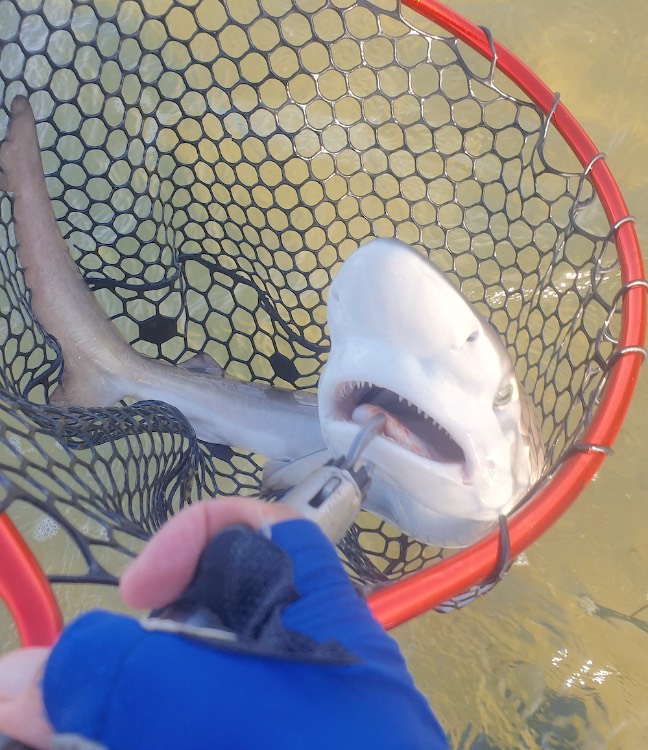
“Bob the Bag Snatcher Bronzy” was at it again. He snuck up from behind and latched onto my catch-keeper bag that I have dangling in the water.
Shooing him off did not work. He was persistent.
When he made one too many swipes at my catch bag of whiting, I thought I should teach him a lesson.
I allowed him to feel comfortable for yet another swipe. When he was just about to launch into my keeper bag I scooped him up with my landing net.
It was a bit of a heavier load for the landing net.
He was a healthy looking 3 foot specimen.
I gave him a stern talking too, a slap on the snoot, took a couple of mug shots for the “Crim files”, and sent him on his way.
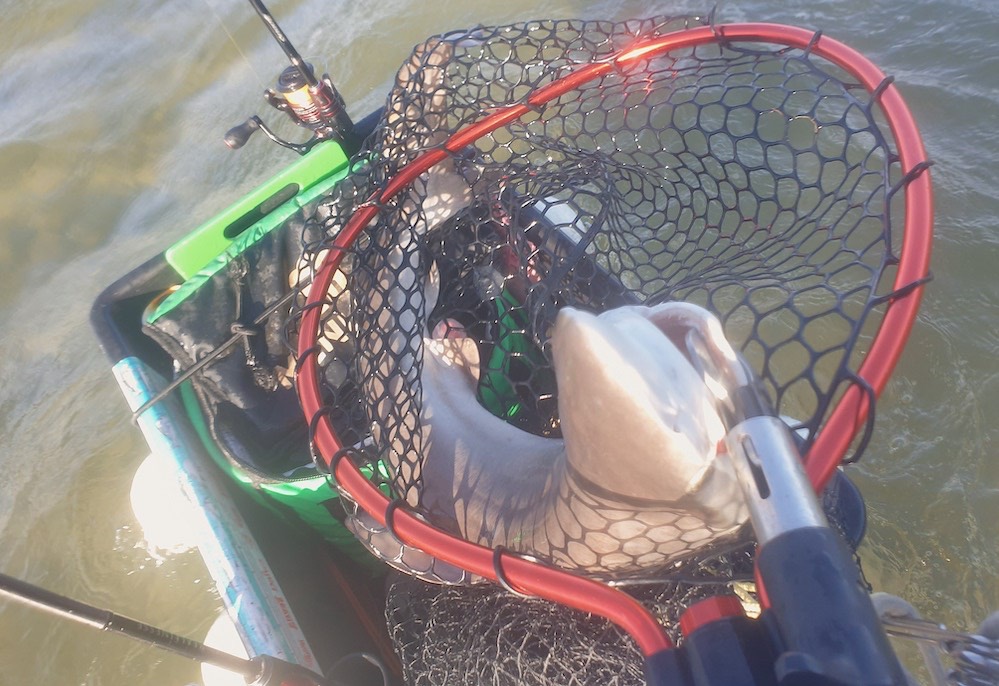
I am told they are very good eating at this size if they are prepared properly after they are caught.
However there is just not enough room in my wading tub to handle the job.
Lucky for the Bronzies!
These guys are frequent but annoying visitors on the sandflats.
Mostly in the 3 to 4 foot range.
They are not a threat, just disturbing. I can assure you they are discerning feeders and far prefer the whiting to the revolting taste of your waders and leg within!
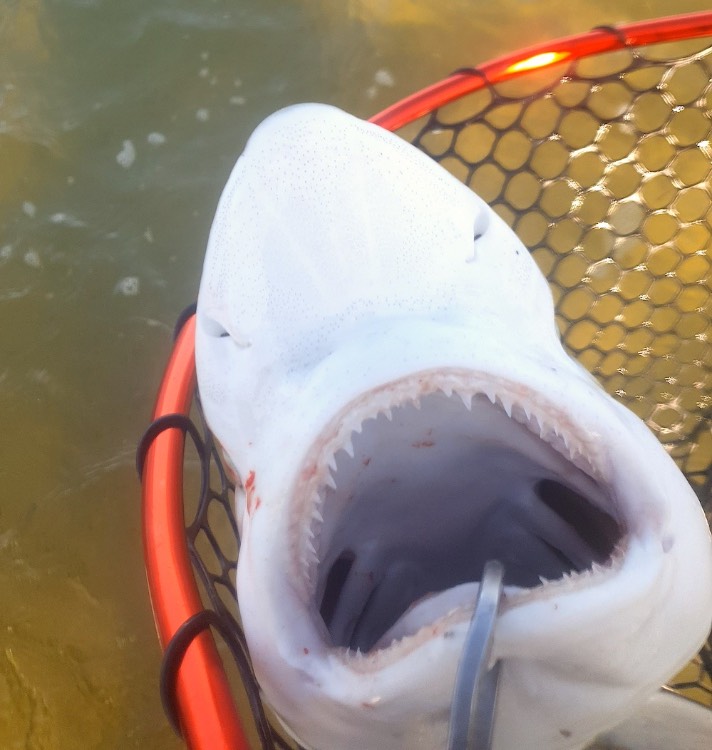
On the occasional dull session I have targeted them with a whiting fillet on ganged hooks. Good fun landing them on your whiting gear, whilst wading the shallows !!!
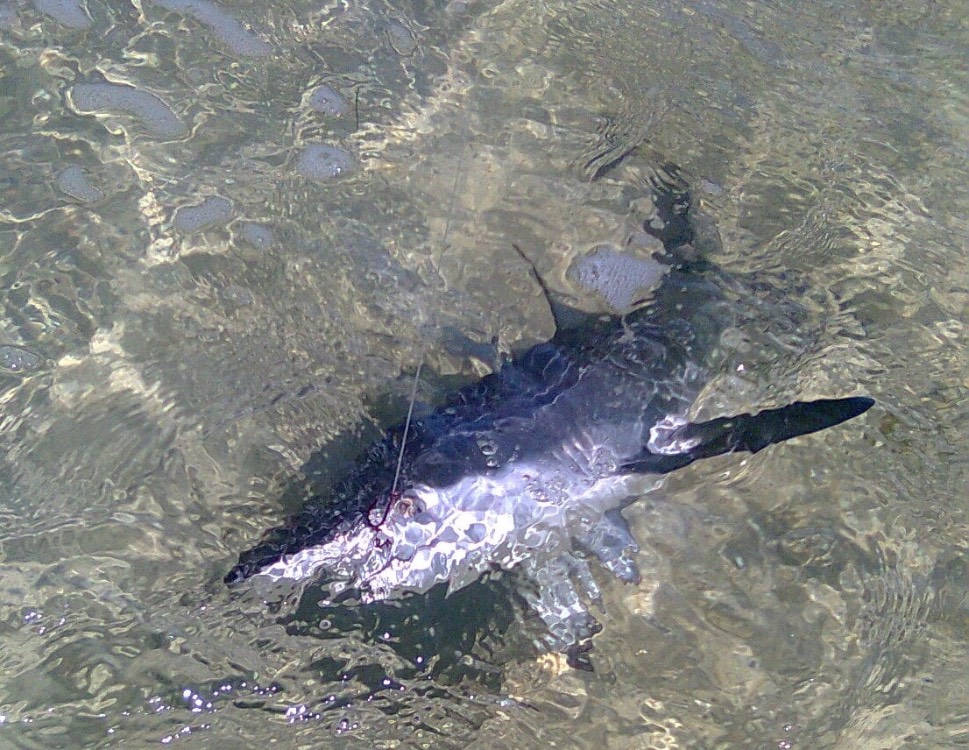
~ One hooked up on a previous session.
The biggest I have come across on the shallow sandflats is a 6 footer, maybe 7 feet. I didn’t hang around for a closer inspection and accurate measurement!
.
My luck had abandoned me today as the weather factors negated each other to provide difficult conditions for stimulating the YFW bite. The wind speed and direction up the gulf, negated the small natural tide movement and the resultant actual tide was virtually at a standstill all day.
Even if only small, Some tide movement is a great stimulant for the YFW to feed.
It was hard work catching and releasing dozens and dozens of smaller fish.
But I still managed to back in a few good horses on cup day.
I finished with four fish around 40 to 41cm. And kept 10 of the better ones, that were mostly around 35cm.
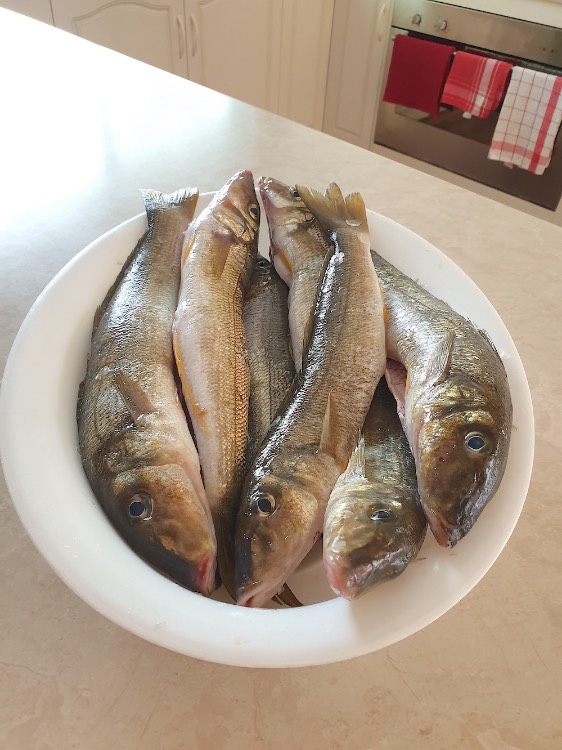 .
.
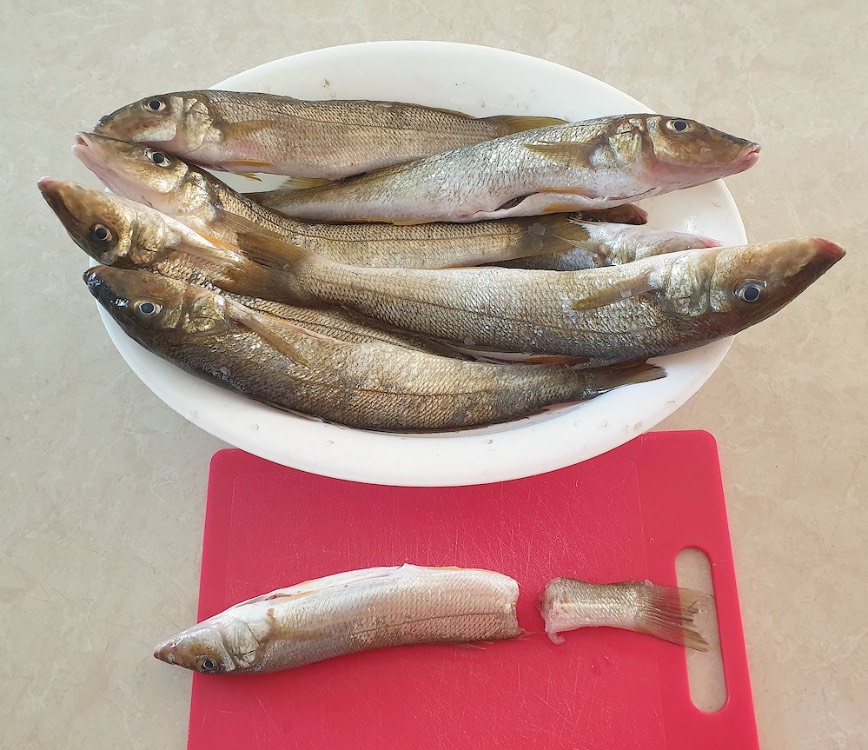
~ "Bob" took a chomp on this one!
Regardless of the fishing, it is always an interesting and enjoyable day wading the sandflats.
Cheers, Des
-
-
-
Regular post readers will know I like to fish the dodge tides for Yellow Fin Whiting .
I cover a variety of reasons in detail, in this previous post:
.
One very good reason, is that you will regularly find better quality fish on the dodge tide.
YFW movements and feeding are highly influenced by the tide. Revolving around the largest tide of the day, they tend to have a 24 hour digestive and feeding cycles.
So even when the tides do not move much on the dodge, they will still have a need to feed within their cycles. The larger YFW have greater food needs and will generally preference a bigger meal such as juvenile prawns or clickers.
With the small dodge tide their feeding will be concentrated to the smaller area, covered by little water flooding in. They will be easier to find.
The terrain/substrate that holds their preferred food will naturally attract a higher concentration of larger YFW.
That terrain you can feel under foot. The softer food holding substrate.
The small tide movement, along with a deeper low tide, holds water over these prime feeding grounds longer. It provides for prolonged access to this zone for both fish and fisher person.
A better explanation of productive terrain is in this post :
.
The dodge tide on Monday with a High of 1.77 mt @ 8.15am and a Low of 0.97 mt @ 11.36pm provided a long drawn out, run off tide. With a prolonged spell under water, of some prime food holding areas. It looked like an ideal tide and I set off fishing.
YFW are always stimulated by tide movement to feed. These tides do not provide much of that stimulus. However there are other factors that come into play.
.
The day started slowly without a strike for the first hour. The warmth of the day gradually started to take effect and the first to stir were some small Whiting.
With the warming arvo came an arvo seabreeze, as well as a predicted strengthening southerly wind. YFW love a heavy rippled surface to take cover under and lose their feeding inhibitions. The bite picked up strongly and catches were now steady. In the constrictions of the upper gulfs any lower gulf southerly wind can force water up. A wind tide pushes in. It further stimulated the YFW and kept the feeding grounds covered with a perfect level of water for a wading fisherman.
.
I caught my bag of 20 in good time. This situation regularly provides quality fish, with10 of the fish ranging from 38 to 41cm. Most of the remaining 10 fish were around 35cm.
Sugapen 95 was the most successful lure. Then again I did not need to use a lot of variety.
The new Sugapen Splash caught it’s share when the afternoon breeze picked up. This is shaping up as the perfect lure for that strong summer afternoon breeze that kicks up a bit of chop.
A few were also taken on the Ecogear ZX, when I was forced to go subsurface as a pack of persistent juvenile seagulls are yet to learn lures don’t taste good.
.
Hopefully we have some more fine weather for the next dodge tide.
Tight lines all.
Cheers, Des
- Meppstas, yellow door 1, gregtech and 11 others
-
 14
14
-
1 hour ago, imfishn said:
Amazing insight and information Des, and what a great haul of beautiful fish ...well done
 it all sounds very promising for us keen anglers. Do you think this pattern will also carry through to our metro beaches for YFW?
it all sounds very promising for us keen anglers. Do you think this pattern will also carry through to our metro beaches for YFW?
Warmer water early in the season will certainly bring them into the metro areas earlier. I saw a post from Brighton Tackle claim they had been sighted locally.
As I have previously mentioned the ongoing heavy netting of this species over winter in the last few years is having a significant detrimental impact on the overall stock status. Hopefully they are resilient and bounce back.



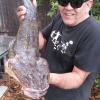


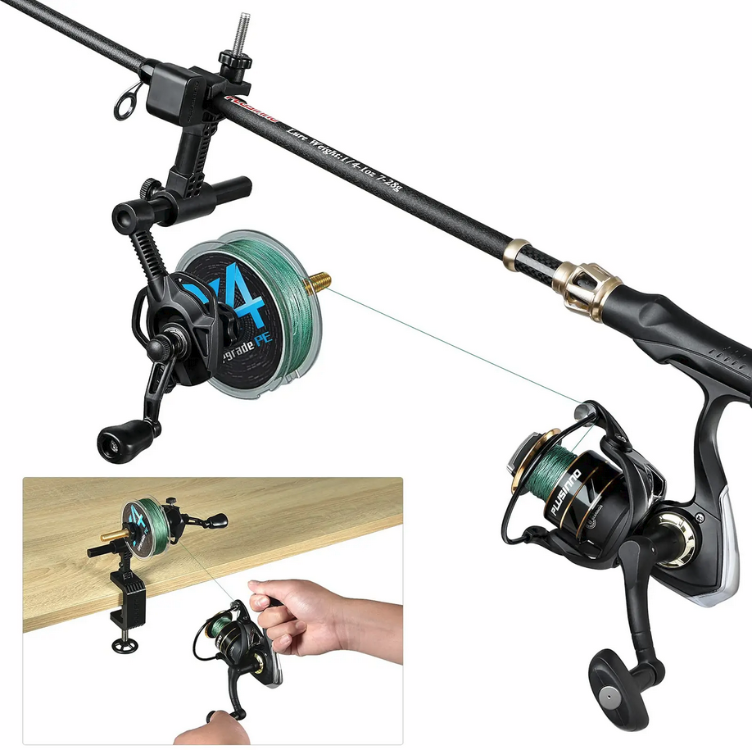
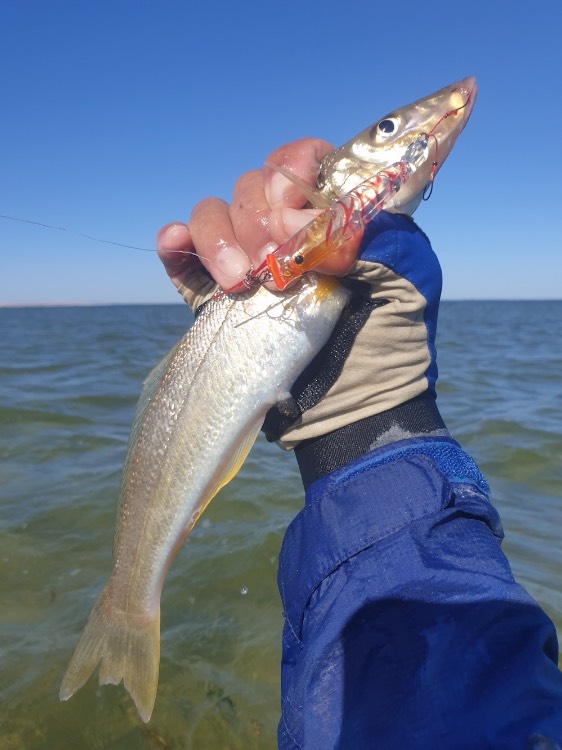
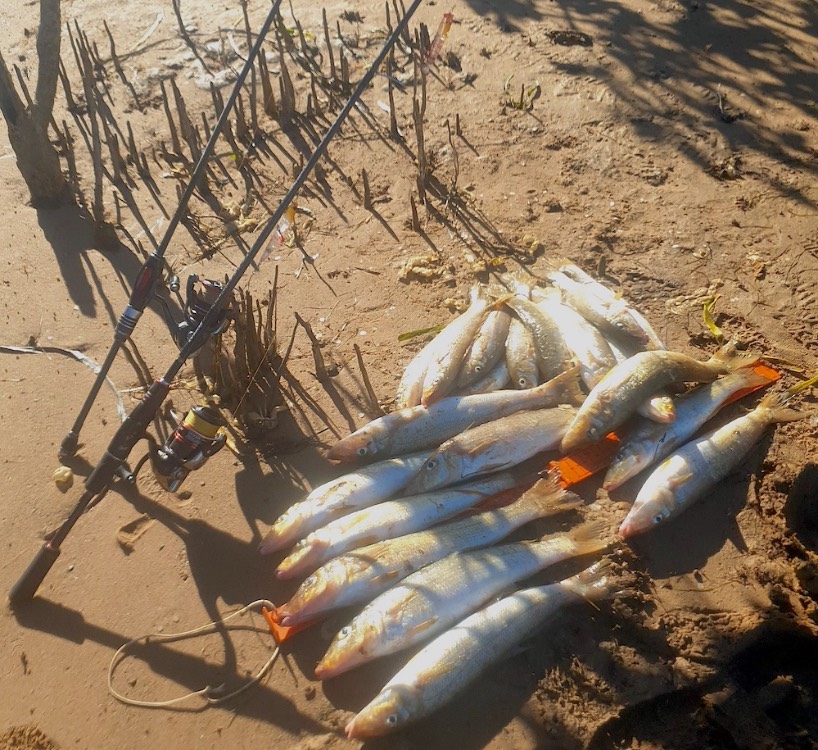
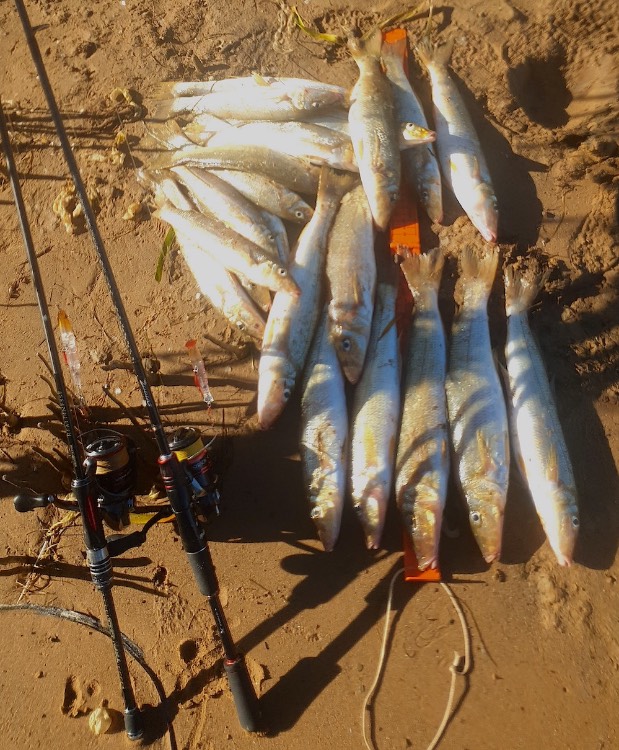
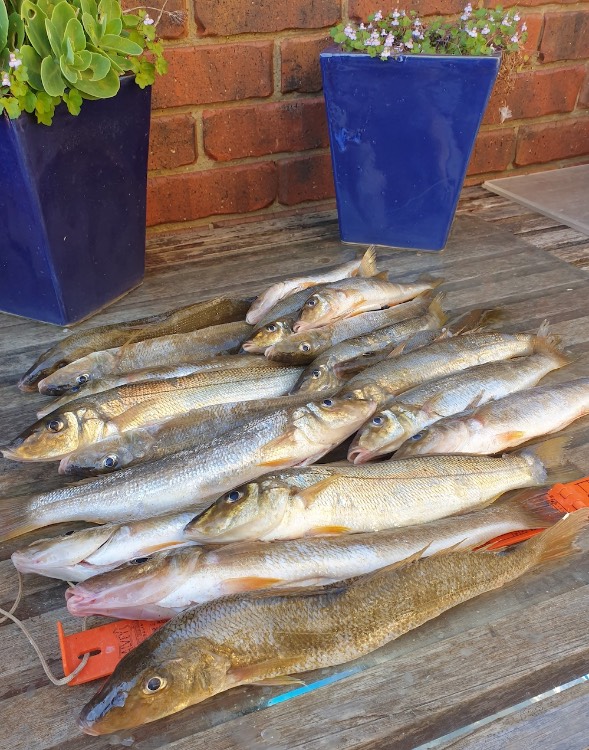
WRACK ON not WRACK OFF.
in Flathead
Posted
The best I have taken is an 81cm “Southern Blue Spotted Flathead”. Back in the day when I was not as aware of the breeding aspects.
The Eastern States Dusky Flathead is a bigger species. So 81cm for a Blue Spot is in the upper end of its size range.